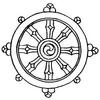Editorial: Galactic Emblems: Tracing The Roots Of The Imperial Symbol
Posted by Eric on December 16, 2010 at 11:00 AM CST
This post is part of ForceCast.Net's editorial series, where our listeners weigh in on Star Wars topics in-universe and in the real world.
Galactic Emblems: Tracing the Roots of the Imperial Symbol
By Matthew Bortolin
Star Wars grandfather* Carl Jung claimed symbols are the best possible expression of human nature’s ineffable aspects—those unknown qualities buried within the collective consciousness and memories of humankind. These indefinable aspects are clarified in symbolic representation, forming cross-cultural and timeless archetypes of meaning. Archetypes can be people, like the bearded, wise wizard (who may or may not live out beyond the Dune Sea), or expressions of humanity’s deep yearnings, such as hope or unity. The eight-prong emblem of the Galactic Republic is a case of the latter – a symbol of unity that was later co-opted and corrupted by the Galactic Empire.
It is the possible origins of this Imperial symbol – the six-branched cog that strikes fear in the hearts of the freedom-loving – that I find intriguing. Its origins may be rooted not in the mysterious temples of Yavin 4 or the ancient catacombs of Geonosis, but in one of the oldest religions of our world. The Hindu Dharmachakra could be the inspiration for the symbol of the Galactic Republic, the emblem that was later altered to represent the Galactic Empire.

The Dharmachakra symbol.The Dharmachakra is an ancient Hindu symbol that essentially represents the cycle of life. (Fans of Robert Jordan will know this as the impulse for the Wheel of Time, the titular inspiration for his popular fantasy series.) The symbol was, in a sense, inherited by Buddhism and is often primarily associated with that religion. The Dharamchakra has eight spokes, each representing one of the categories of the Buddha’s Eightfold Path, and is often referred to as the “Dharma Wheel.” It is said that when the Buddha first preached his insight to his friends in the Deer Park he set the Dharma turning. It continues to roll along to this day. (By the way, Dharma can mean the Buddha’s teachings and it can also mean Truth or “the way it is.” Most recently it has come to signify a female character on a painfully contrived American sitcom.)
The symbol of the Galactic Republic, like the Dharmachakra, has eight spokes. Also, like the Dharmachakra, it was borrowed from a pre-existing community—namely, the Jedi Bendu monks. Jedi Bendu was the term for the Force-wielding monk-warriors in the earliest drafts of
Star Wars. Shortly thereafter, George Lucas revised the name to simply “Jedi,” but apparently the Bendu still made their way into official
Star Wars history as precursors to the Jedi. The Bendu played a role in unifying the disparate worlds of the galaxy under one government and so their symbol was used as the emblem of the Republic – the democratic institution that gave thousands of worlds a voice in a collective chorus.

The symbol of a pre-Galactic Republic group known as the Bendu.The Bendu symbol relates to the sect’s view of numerology, which touted the number nine as the hallmark of unity. The eight spokes joined to one disc (8+1=9) then represent the Force in a united galaxy.
Years later, Palpatine rose to power and being the avid and dedicated admirer of both the Republic and the Jedi that he was, he decided to honor their symbol, as it were, and “retire” it. The new Imperial symbol was born, bristling with not eight, but six spokes. Why exactly he removed two is not clear, but it was an obvious defacement of the revered emblem that had stood for a thousand generations.
Palpatine’s corruption of the Bendu symbol calls to mind another defiled ancient symbol: the Hindu swastika. As it did with the Dharmachakra, Buddhism borrowed the swastika from Hinduism as a symbol of well-being and balance (which are pretty much synonymous). And just like with what happened to the Bendu symbol, the swastika was appropriated and twisted by a reprobate of galactic proportions. Adolf Hitler saw in the swastika a link to the ancient Aryans who once ruled northern India. The Aryans were, to his deluded mind, the master race. He flipped the usually left-facing swastika to peer right and gave it a slight tilt that effectively ruined its balanced state—an appropriate distortion given the unbalanced nature of the Nazi regime.
Jung would no doubt have found the Bendu symbol fascinating. It not only conveys the meaning of unity, tying all life forms together in a “symbiont circle,” as Obi-Wan might say. It also connects with his fascination for Hindu and Buddhist mandalas, circular works of art representing wholeness of person and world. This was the purpose of the Bendu symbol, to display in one simple sign the eternal truth that cannot be fully described with words: We are perfectly whole in this moment, entirely unified with the universe and all its beings. Such a notion suggests life beyond dualism, a life where good and bad, light side and dark side, and most importantly, life and death are not facts, but mere ideas of the mind. With the reality of unity, as the Bendu suggested, we are truly one with the Force, always.
---------------------------------
*Carl Jung had a powerful influence on Joseph Campbell, who, in turn, had a profound impact on George Lucas.
The views expressed in this editorial are those of the writer and do not represent the views of the ForceCast team. If you have questions or comments about these editorials, please email ForceCast Senior Web Editor Eric Geller.
Related Stories:



